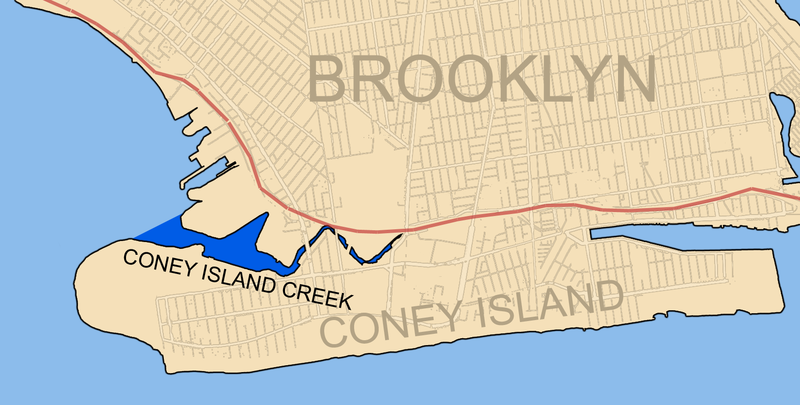
As you can see, Coney "Island" is now a misnomer. It was divided from the Brooklyn mainland by a slender creek which was continually accumulating silt. Gradually, the slender sliver of water between the mainland and this western most barrier island of Long Island became a land fill. Coney Island became not an island at all, but a peninsula which hangs off the south end of Brooklyn like a dangling foot. The island was discovered in 1609 by Henry Hudson, the English explorer who spent much of his exploration time looking for a sea passage across Canada and the northern United States to China. Geography of the Earth was a little sketchy in the 17th century.
However, it was the Dutch who originally settled the New York City area, and the name 'Coney' is thought to be a English corruption of the Dutch word for rabbit. Truthfully, though, no one really knows this for a fact. Today, Coney Island is a Brooklyn neighborhood of about 30,000 people. The southern shore of the island has been a seaside destination for all of New York City since the mid 1800's.
The Coney Island heyday began in 1880 and continued until post WWII. Coney Island amusements represented the change in the leisure activities of Americans. People immigrated from overseas, or left rural areas, and flocked to the cities. 19th century/early 20th century urbanites had no desire or even ability to 'sit on the front porch' during their limited leisure hours. Huge numbers of the New York City population were desperate to escape their tenements, especially during the hot New York summers. Large urban parks as well as large mechanized amusement parks showcasing electric lights, and other marvels of the roaring Industrial Revolution were constructed all over the country in response to the thirst for leisure entertainment.
The three amusement parks (Luna, Dreamland, & Steeplechase) on Coney Island represented the pinnacle of amusement parks of the era. Adding the seashore into the entertainment mix made Coney Island a 'must go' destination. Completion of the Brooklyn Bridge as well as electric trolleys and finally a subway line opened up Coney Island to all of New York City. A boardwalk system was completed in order to disperse the large crowds flocking to the island. We walked along the Rigelman Boardwalk completed in 1924.
In addition to the savory entertainments, Coney Island was also home to numerous brothels and gambling halls during the late 19th/early 20th century.
The post war suburban flight together with expanded leisure opportunities sent the Coney Island amusement parks into a long slow decline. Today, there has been a recent revival of the amusement parks on Coney Island due largely to a new minor league baseball stadium as well as the revamping of the New York Aquarium. The beach looks well clean, groomed, and it's even handicapped accessible. And, there's lots of neon and fast food opportunities all along the boardwalk.
 |
| Luna Amusement Park |
Today, Coney Island is known as the home of Nathan's Famous Hot Dogs. This company has been selling hot dogs since 1916 out of the same location.
Of course, we had to eat here. Drake went for the hot dog, which is a recipe devised by Nathan's wife in 1916, and still made exactly to that recipe today. The french fries were fresh cut and the onion rings perfect. No wonder these folks are still in business. Each 4th of July there's a 'hot dog eating' contest which is baffling and nauseating to me, but it's wildly popular. The current champ ate 71 hot dogs this year. (Barf!)
This is a fascinating place. You can feel the 19th century working class marveling at the wonders in the amusement parks and the excitement of the side shows, the barkers, the moving pictures, and the carnival atmosphere which was available any day you caught the trolley to the island. Today, the atmosphere is more sedate and in many ways less exciting, but it's still like a carnival, and it's still available any day you catch the Q or B Subway lines to their southern terminus.


